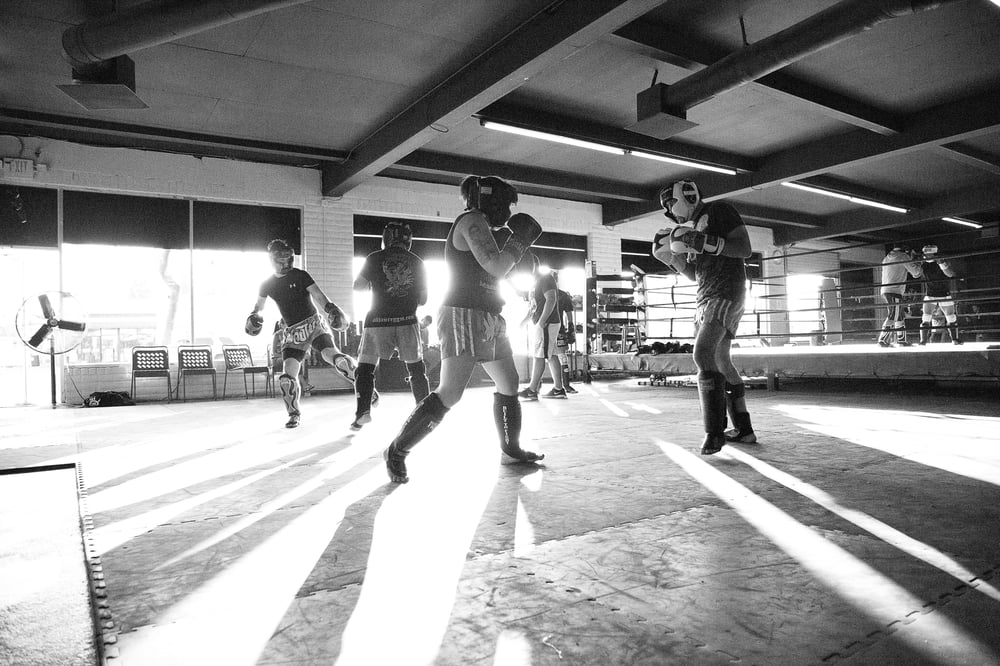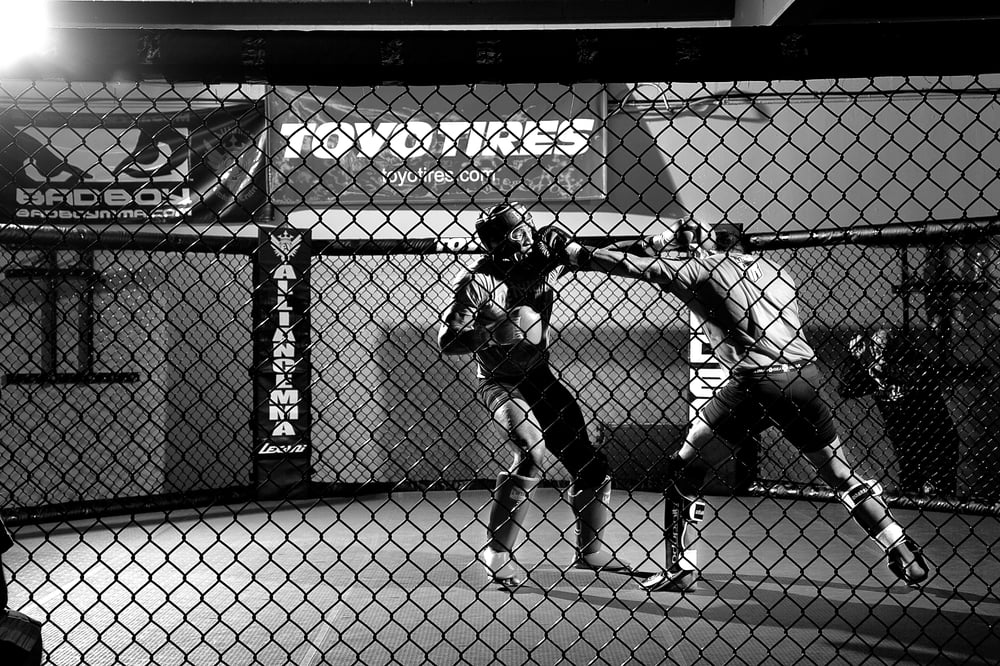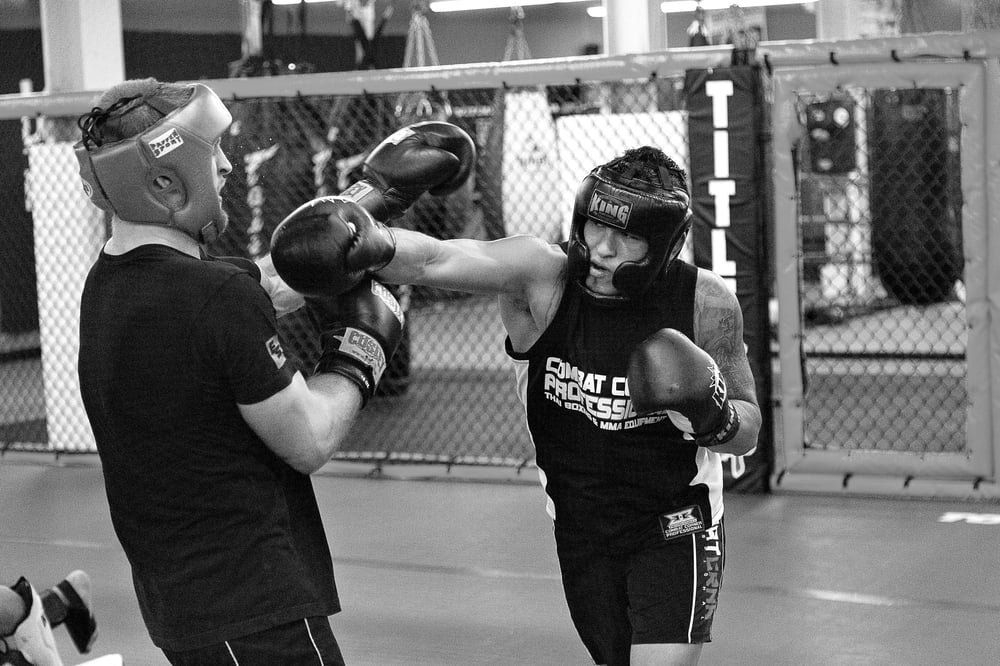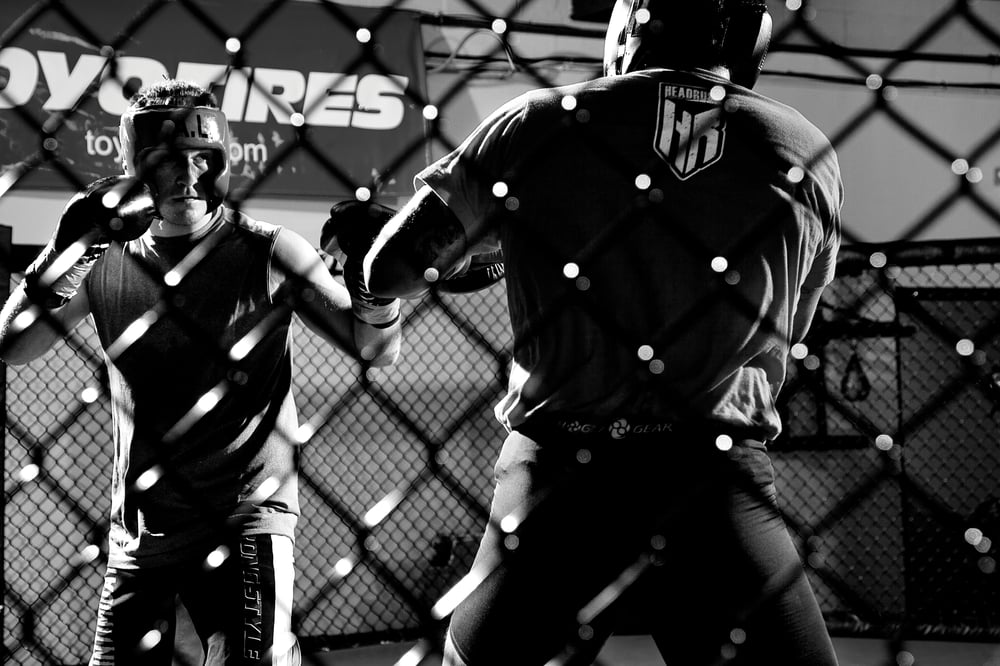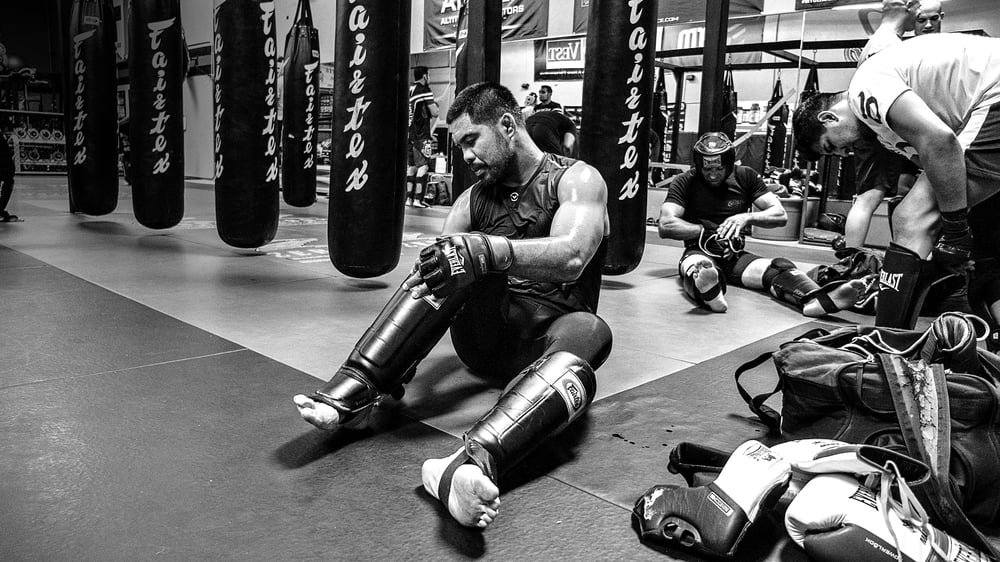
Issue 116
July 2014
Concussions remain one of the hottest debates in pro sports, and MMA is no different. After a series of revelations regarding changing sparring practices in the sport, FO speaks to some of the UFC’s biggest names to discover their views on knockout prevention.
How many times can an athlete get knocked out and still perform at 100%? Five times? Ten times? Once? It’s the $64 million question in fight sports. In fact, in a couple of other pro sports too. So how many serious blows to the head can each of us take in a lifetime without suffering irreparable damage?
Research and annual knockout percentages suggest mixed martial arts isn’t as brutal as, say, boxing when it comes to athletes suffering from head trauma. And that’s thanks largely to the fact it’s rare for fighters to suffer repeated severe blows to the skull without a fight being halted. Unfortunately research only examines results in competition, and for every 15 or even 25 minutes spent in the ring or Octagon there have been hours spent sparring in the gym in preparation.
For every Anderson Silva knockout live on pay-per-view there are dozens of KOs and concussions suffered in the gym that go completely unmonitored and unchecked. Fighters still see taking head shots while training as the best way to experience what’s to come when the bell goes inside the ring. But at what long-term cost to their health?
And even once you’re comfortable with being punched or kicked to the head, would it not make sense to stop sparring in the gym and only suffer any possible consussions when they matter most – when in front of thousands with money and, perhaps, titles on the line?
UFC welterweight champion Johny Hendricks, for instance, says he no longer takes head shots in sparring, in an effort to save his faculties, and keep his reflexes in tip-top condition, for when he’s inside the Octagon. While his most recent opponent, Robbie Lawler, also admits he spars only sparingly these days after more than a decade of being dazed both in the gym and inside the ring.
33% – In 2013, around 33% of all UFC bouts ended by knockout or TKO
However, they’re two of just a handful of MMA’s biggest stars who are actually changing the sparring aspect of their preparation. And that’s because fight sports, perhaps more than any other, are deep rooted in tradition and fight camps. Entire MMA teams are usually built on the old proverb ‘iron sharpens iron’ with gym wars and initiations a part of everyday life in the pro environment.
Trauma study
Middleweight Mark Munoz, is at the forefront of a paradigm shift in the way fighters take head shots and approach sparring in the gym, and in camps, both in the short-term and the long-term. His switch in mind-set has come in the wake of his own involvement as a subject in ongoing trauma research within MMA, and his subsequent examination of recent studies published on the subject.
In February, UFC CEO Lorenzo Fertitta took part in a press conference in Washington DC in support of the Cleveland Clinic study on fighters’ brain trauma and spoke to the media about the landmark research as it relates to concussions, and more.
And Munoz, who as well as being one of the planet’s leading 185lb fighters also holds a Bachelor of Science degree in health science, makes a surprising admission when he speaks exclusively to Fighters Only on an issue close to his heart, and perhaps more importantly his head.
He says: “I’m actually participating in that study. I went to the Cleveland Clinic in Las Vegas and they did a series of tests on me. And I’m perfectly normal. But they’re going to study me over time. They said I have a good memory.”
Yet Munoz has suffered serious concussions, which he’s happy to acknowledge, while also revealing major changes have recently taken place in MMA. And more are on the way. And these changes could revolutionize the way fighters take head shots.
“The bottom line is that we’re not sparring as much. I always encourage the guys not to knock each other out in practice – I always have,” offers the Reign MMA owner. “But now with the recent studies of brain trauma and head injuries, we know it’s irreversible. Head shots have an effect on people and I’ve always been an advocate of not going so hard that you knock each other out. When I see someone doing that I’ve actually kicked some guys out of my gym because they were trying to knock people out.
“Look, you do push each other, you need to be able to take shots, I do understand that, but at the same time you’ve got to take care of your training partners because you don’t want to leave the best that you have inside the gym.
“You want to leave it inside the Octagon so if you’re getting hit repeatedly in the head in practice you can’t physically give your best inside the Octagon.”
Iron sharpens iron
Rafael Cordeiro, head coach at Kings MMA and former coach at the famed Chute Boxe Academy, comes at the issue with a completely opposite point of view. After a lifetime at the very pinnacle of MMA coaching, the 2012 Fighters Only World MMA Awards ‘Coach of the Year’ insists full-contact sparring is not only a necessity to a fighter’s career, but a prerequisite to becoming a prizefighter.
6.3% – A study of training and competition injuries incurred by US Olympic boxers, who only throw shots to the head and body, between 1977 and 1987 found of the 447 injuries only 6.3% were concussions
“Guys who have decided not to take head shots in sparring anymore would not be able to train at my place,” Cordeiro says. “I believe sparring is one of the most important things a fighter needs to do. Sparring is a major part of the game and if you don’t spar for real then you will never truly know if your technique works or not.
“In my gym all my fighters spar, and spar hard. Sometimes three days a week, sometimes twice a week. But I truly believe that sparring makes a huge difference in a fight. You can only truly work a good game plan when you have also had the right sparring against the right people.
“For example, for the Travis Browne fight, Fabricio (Werdum) sparred with Alexander Volkov, the Bellator fighter who is also six-seven, like Browne, and we used him to develop our game plan for the fight. And these guys fought. Believe me, each sparring session was a real fight; five-round fights. And that’s what best prepared Fabricio for the Browne fight, and allowed him to fight at the tempo and with the pressure he did to win.
“In sparring you learn what works and what doesn’t and it worries me that some guys are not sparring properly for fights. In my opinion that means only one thing: their quality will go down. That’s my opinion.”
One of the most debated issues of late, and something Mike Bisping admitted to in the run up to his most recent outing against Tim Kennedy, is the propensity for ‘old school’ MMA fighters not to wear a head guard in sparring – sometimes for the duration of their career, which can average between six and 10 years.
Speaking didactically, Bisping said: “If any young fighters out there want to listen to a great piece of advice, wear a head guard. I’m convinced my eye injury has come about because of this.
“I’m all macho about it, but it’s sensible for the new breed of fighter to get used to wearing a head guard early in their career. We can be macho about it, say it makes your senses sharper and all that stuff, but the truth is, a head guard will help prolong a career.”
Munoz concurs. He also now strongly advocates wearing a head guard in sparring. “Yes, I wear a head guard. I haven’t always. The reason why I wear a head guard is that it doesn’t stop the fact you’ll get a concussion if guys are hitting you really hard in the head, but it stops you from getting cuts.
“I’ve had cuts happen to me before fights and I’ve had to get stitched up two weeks before them. For my Chris Leben fight I had to get stitched up before; so too for my fight with Demian Maia. I look back and I wish I’d been wearing headgear then. But I’ve been wearing it ever since.”
Spar sparingly
The thinking, therefore, logically, is that fewer dedicated sessions may become the rule where fighters take and land heavy head shots. Munoz says: “That time is on it’s way already. We are certainly doing that at my gym, or on the way to do doing that, because there’s research being done – longitudinal studies – and research already stating head trauma is basically caused in training with second onset concussions, or even third or fourth onset concussions.
“And that’s when it can get really, really damaging. I look at the research that’s being done because it’s improving our sport, and it’s improving defense.”
Yet surely there has to be a fine line between limiting head shots in training and learning to deal with being dazed by a head shot. Every fighter has to know how to react in that moment.
2% – Boxing gloves only absorb 2% more force when delivering a punch than MMA gloves, according to National Geographic
Urijah Faber, leading bantamweight star and head of Team Alpha Male, the 2013 Fighters Only World MMA Awards ‘Gym of the Year’, agrees with Munoz, in that head shots can eventually shorten a career. However, he sees no other option but to fasten up the head guard and swing away.
“There is some merit to taking less head shots, especially when guys are getting older and are taking more care with blows to the head, and are also training smart,” says the former WEC champion and two-time UFC title challenger. “But there needs to be some sparring for guys to get familiar with getting hit. I mean, it’s not a natural thing so that’s a part of our sport that you can’t avoid altogether.
“You can minimize it, especially if you’ve been in the sport for years and you’re comfortable getting hit. But not everyone is, and it’s not something people are instinctively good at. Actually it’s probably one of the only things where your instincts are completely wrong, to put your head up and lean out of the way and stuff like that. So we have probably a little bit less intense sparring but you still have to do it in my opinion.”
He adds: “We still have full-contact sparring days at Team Alpha Male. It’s just simply a necessity for guys to get comfortable getting hit. I believe the only way to prepare for battle is to go into battle. After all, it’s important to get into a real fight long before you fight professionally, obviously.”
This lack of experience in taking head shots Urijah is talking about perhaps most famously ultimately proved the undoing of Brock Lesnar. A face punch panicked the former heavyweight champion, and it appeared he had neither drilled nor practiced it to the point of normality. Perhaps some fighters, if the ‘no head shot’ regime takes over, could face the same dilemma.
Concussion comfort
“You have to take shots at some point, and you’ve got to learn that. You’ve got to learn that stuff, so you’ve got to get hit,” argues Munoz. “But I was ignorant of the fact that head trauma is a big thing and it’s irreversible. So I started doing research by myself on concussions, way back in the UFC in 2009, when I got kicked by Matt Hamill.
“Prior to that fight I’d suffered a concussion in training. And then I got kneed in the head while sparring. So I suffered two concussions in the week before meeting Hamill. I remember feeling dizzy lying down in the dressing room before I went out to fight him. I felt like the room was spinning. And then I was out for a long time after I actually got knocked out in the fight.”
It sounds worrying, too. Indeed, how many times in a long, grueling five-round war have fighters such as, say, Frankie Edgar, suffered concussions. Heart, desire and sheer toughness carry many of these warriors through those moments, but to what eventual cost?
Edgar, a former lightweight champion, and current TUF coach, admits that in the early days safety was secondary when it came to sparring. But today, while he still goes at it at least three times a week full-contact, he wouldn’t dream of exchanging in the gym without the proper protection.
12 – Dr Charles Bernick found MMA fighters and boxers with more than 12 years’ experience training and competing in the ring exhibited a decline in cognitive function
Edgar says: “I’m definitely an advocate of sparring, it’s the only real way to get a feel for the fight. But I always make sure I wear headgear, that’s definitely something that over the years I’ve learned.
“Early on, before I really trained properly, then I used to mess around and fight with the small gloves and stuff but that was a long time ago now; now I definitely wear the right gloves and headgear. You’ve got to wear the bigger gloves when you’re really going hard.
“Also, the guys are much better too. I train with professionals, it’s a pretty solid team and we’re all pretty technical guys, so it’s all very much controlled. And you know what to expect.”
Unreported KOs
With just four career defeats, and all on points decisions, blotting his 21-fight record, Edgar shakes his head at the notion of him ever being knocked out in sparring, but the instances of that can be a common occurrence in fight camps – especially when there is more than one athlete preparing for a fight.
But how many times have TV fights been canceled because an athlete admits to being knocked out in camp before the first bell, offering himself up for a medical suspension long before he can cash his check? And that’s one area of the sport which concerns Munoz.
Taking trauma in a fight, reasons ‘The Filipino Wrecking Machine’, is one thing. In training, in camp, in sparring, that’s another thing altogether. But, if he were to suffer a KO now in sparring, would he go and see the doctor and declare it? “Yeah, I would. That is wisdom,” Munoz reasons, “because if you put the fight over your health and your wellness, it has to be wrong.
“What is more important to you?” he asks. “Your family, your wife and kids, or the fact you are getting to headline a UFC event? I’m going to pick my family over that any day.
“You’ve got to have your priorities, you’ve got to have that in check because I want to walk my girls down the aisle. I want to be a role model for my son, and coach my son because he’s wrestling now. I want to be there for my wife.”
These are choices. And very important ones. But how many fighters, faced with a huge payday headlining a card, would follow Eddie Alvarez’s bold move recently and withdraw because of a concussion? How many would even declare it? Alarmingly, very few.
Not until they see the effects repeat concussions have on other fighters as the sport moves on and fighters age.
...

